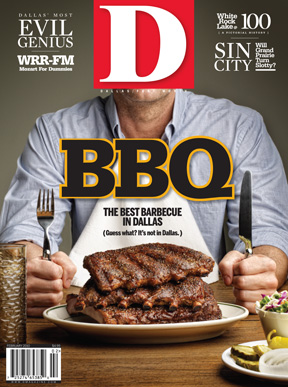Organic change comes to a city so incrementally that often we don’t notice it. I certainly hadn’t until I drove down Henderson one day and was struck by the, to me, sudden renovation of the street as it approaches Ross Avenue. Organic change—the kind that isn’t planned or city sponsored but advances little by little in fits and starts—always presents a deeper meaning if we try to grasp the forces behind it. In this case, the force is market demand by younger people.
Knox-Henderson runs 1.4 miles from the Katy Trail to Ross Avenue, changing from one name to the other as it crosses over Central Expressway. Only a decade ago, Knox Street was a rather tattered shopping street, and Henderson was the northern boulevard of the lower East Dallas barrio, lined with taquerias and beer joints and a Mexican grocery store.
In the 1990s, investor George Bayoud built some apartments on the north end of Knox and then wondered how to get people to live in them. He could attract better tenants if the street itself were more interesting. With the Highland Park Cafeteria gone, Knox’s only assets were the legendary, if tiny, Highland Park Pharmacy and Weir’s Furniture, which had weathered the ups and downs of Knox since 1948. Bayoud observed the traffic Weir’s attracted. If people were coming to Knox to buy furniture, he reasoned, why not give them more choices? Pottery Barn and Crate and Barrel liked his logic, and Knox was reborn as a furniture-shopping destination.
In 2000, restaurateur Tristan Simon was looking for a location. The rents on Knox by then were too expensive, but the activity on the street convinced him that customers would make the jump across Central to Henderson. He opened Cuba Libre Cafe in a triangular space at Henderson and Willis. Within two years, his business had blossomed into a mini empire (with Sense and Candleroom, and later with Hibiscus and the Porch) catering to a hip and moneyed crowd who nightly spilled out into a once-deserted street.
Simon’s success did not go unnoticed, especially by Marc and Roger Andres, whose father had years before bought up several tracts along Henderson. They began to think that what Simon had started could extend down the entire street. In the last three years, the brothers have gutted, torn down, or remodeled old structures, introducing restaurants like Park, Sushi Axiom, and Urbino to a neighborhood that last year saw its first new single-family homes in decades.
A decade ago, when people talked about urban infill, they meant immigrants moving into places like lower East Dallas, which middle-class whites had long ago deserted, occupying cheap apartments and weathered single-family homes. Along East Dallas streets like San Jacinto and Fitzhugh, the vestiges of this kind of urban migration are still with us.
But the definition is changing. Urban infill today attracts a younger, more ethnically mixed crowd. The change on Henderson Avenue is patchy, but as the apartments begin to fill, we could be seeing the harbinger of a new lower East Dallas. Unlike a suburban housing development, it won’t pop up overnight. But with more young people wanting a less expensive version of Uptown, my guess is that in a decade, lower East Dallas will be one of the hottest spots in town.
AN APPRECIATION AND AN APOLOGY
Our 35th anniversary issue, published last month, is truly a collectors’ item, with contributions from a stellar cast of people who have played a role in Dallas’ modern history. Among those was Ross Perot Sr., who wrote about his decision to move the headquarters of EDS to Plano, thereby creating Legacy as one of the nation’s premiere locations for corporate headquarters. In an issue so complex in execution—with more than 35 contributing authors and umpteen photographers and illustrators—signals can get crossed, and they did with the comic illustration accompanying Mr. Perot’s article. We admire Mr. Perot, we appreciate his joining in our little historical enterprise, and we apologize that the illustration did not reflect either our admiration or our appreciation.
Write to [email protected] .






